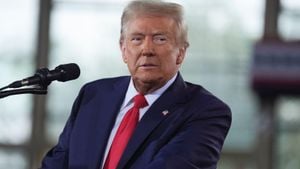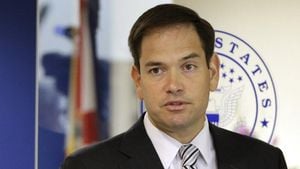Donald Trump is back at the forefront of American politics, and with him, the questions about his economic policies have reemerged. His recent return has ignited discussions about how his strategies might shape the economy once again. Following his victory and the Republican Party's control over both the Senate and the House, analysts have been quick to forecast the potential ramifications on markets and inflation.
Post-election, the stock market showed impressive momentum. The Dow Jones Industrial Average, S&P 500, and the tech-heavy Nasdaq all achieved record highs. Historically, the market tends to thrive after presidential elections, but Trump's return has added layers of excitement—even among stock traders. Sam Stovall, who serves as the chief investment strategist at CFRA Research, observed, "This 'red wave period' is the best scenario for a Republican president when it concerns the stock market," citing data indicating significant market gains during similar periods.
Small-cap stocks, alongside traditional sectors like energy, thrived following the election, buoyed by expectations of corporate tax reductions and diminished regulations. The regulatory environment surrounding financial institutions is predicted to undergo significant changes, as well. But not all predictions paint such rosy pictures. Analysts warn of the economic risks posed by Trump's proposed policies, especially his plan for imposing substantial tariffs on imports, including Chinese goods. Economists express skepticism, indicating these tariffs could raise consumer prices and worsen inflation, contradicting what Trump claims about their benefits.
Inflation itself has been on many people's minds. A spike to 9.1% was recorded back in June 2022, largely due to pandemic-related issues affecting supply chains. While inflation has since moderated, the angst over rising prices remains, with many voters citing it as pivotal to their support for Trump. It's worth noting, as reported by asset management firms, major industries—including automotive and electronics—would likely feel pressure under substantial tariffs. This tension points to what some deem as perplexing economics: Trump's mass deportation blueprint for illegal immigrants also stands to complicate matters. Analysts warn it may tighten labor markets and impose upward pressures on wages, which could contribute to inflation, particularly within low-wage sectors like construction and agriculture.
The potential ramifications of Trump's policies on the economy are as multifaceted as they are volatile. The Peterson Institute for International Economics suggested the collective impact of tariffs and mass deportations could lead the U.S. to face national income constraints, reduced employment opportunities, and projected inflation rates between 6% and 9.3% by 2026.
Less politically polarized sectors continue to advocate for focusing on broader economic fundamentals. Rob Haworth, senior investment strategy director at U.S. Bank Asset Management, asserted, "Our data shows, over time, it’s really still about the economy, and earnings growth is considerably more influential than merely election outcomes." The U.S. economy witnessed solid growth, measuring 2.8% annually during the third quarter, backed by consumer spending expansion of 3.7%.
On the tech front, companies like Alphabet, Amazon, and Microsoft announced strong earnings, beating expectations—indicating sound economic health, at least for some sectors. This positive momentum is bolstered with the Federal Reserve cutting interest rates to promote economic growth. After suspending the benchmark rate on Nov. 7, another cut is on the horizon for December, lending credence to predictions of continued accessible capital inflow.
Nevertheless, the economic forecast presents challenges. Experts persistently caution about impending market shifts which could taper down after 2025. Stovall warned stock valuations may become problematic if they continue steeping upward amid still uncertain Trumpian reforms.
Yet, Trump and his supporters hold steadfast beliefs about the necessity of deportations. Housing leaders and economists concede the labor force for construction is already struggling. Home construction industry leaders express fears Trump’s mass deportation plans could deplete their workforce, exacerbated by the 500,000-worker shortage they currently face. Historically, immigrant labor has played a significant role within construction—one estimate suggests about 25% of this workforce comprises foreign workers, with 15 to 23% being undocumented.
Vice president of demographics research at John Burns, Eric Finnigan, commented on the potential consequences, stating, "If mass deportations happen, much of construction, remodeling, and repairs come to a standstill. Prices could increase dramatically." Even before any formal action is taken, the threat of deportations has already caused anxiety among workers, making many uneasy about their job security.
Trump and his administration push the narrative forward, insisting these changes could, paradoxically, stabilize housing prices by reducing demand. From this standpoint, some typically argue against the deportations, with Trump pointing fingers at immigrants for driving up housing costs during his September address at the Economic Club of New York. Conversely, critics within the housing industry argue there’s minimal evidence to support the idea of available American laborers waiting for jobs, stating many prospective builders, especially younger workers, prefer remote or low-stress occupations over demanding labor.
So the discourse continues: Can Trump’s plans drive job creation and alleviate inflation? Or will they merely complicate the already volatile financial sphere?
Much like any economic narrative, the plot has both heroes and villains, and economic experts stand divided over which path should be taken. One thing’s for sure: the ways these policies filter down to everyday workers and consumers will shape the next act of this ever-evolving story ravaging the American economy. With looming tariff discussions, potential mass deportations, and ever-fluctuating market behaviors, the coming months promise to be rife with tension and uncertainty, ushering American businesses and households alike through what could be another rollercoaster term for the volatile economy.



